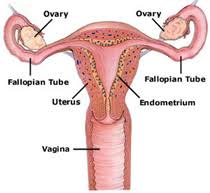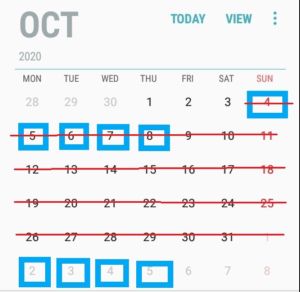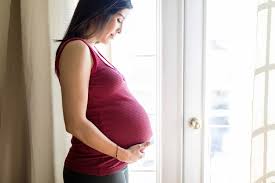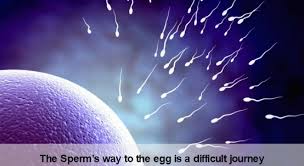
Unwanted pregnancies are a big problem, as well as wished but unfulfilled pregnancies.
Women are known to be complex human beings, and that's somehow true. However, they are not as complex as we might think.
Their periods are sort of a myth to most people, but, as the name indicates, they are periods (meaning they follow a regular pattern). As such, mastering them will permit you trick the system. To know when to have sex with or without contraception, when to expect your menses, how to increase the probability of having a boy or a girl.
The Concept behind the Pattern (Menstrual Cycle)

Menstrual cycles range from 21 to 35 days and are 28 days on average.
They start with the discharge of blood from the decomposed uterine lining. Periods last from 3 to 7 days, varying according to the woman.
The ovaries produces egg cells; which when mature, the most well grown egg cell will be sent to the fallopian tube. During this maturation, oestrogen and progesterone (the female sex hormones), are produced. They cause the thickening of the uterine lining in order to receive the zygote (fertilised egg), in case of fertilisation. Half-way the menstrual cycle (14th day for a 28-days cycle), the mature egg is being released to the fallopian tube. This process is called ovulation and this day the ovulation day. The egg stays about 1 day in the fallopian tube and if no fertilisation takes place, it will be discharged.
As result, the oestrogen and progesterone production is ceased, while another hormone called the luteinising hormone is produced. LH causes the breakdown of the aforementioned thickened uterine lining. When decomposition is complete, the waste materials are sent out in the form of blood. This marks the beginning of a new a cycle.
NOTE: Menses are less regular in young girls who just started to have their menses. It can take 3 years for some to become a more regular pattern.
Calculating Length of Cycle (an example is given at the end)
In order to calculate the length of a cycle, do the following:
Record the 1st day of your periods for 2 consecutive periods.
Count the number of days between them.
Do that over 4 consecutive periods. Then average those lengths by summing them and dividing by 3.
Example:
Someone, say Annah, has her menses from October 4th to October 8th.
Then has her next menses from November 2nd to November 5th.
She counts the number of days between October 4th and November 2nd.

That is 29 days.
Then, she has her 2 following periods from December 2nd to December 6th and January 1st to January 4th consecutively.
She counts the number of days between those periods .i.e.
-From November 2nd to December 2nd which makes 30 days.
-From December 2nd to January 1st which makes 30 days.
Length of Cycle (Lc): Sum of those lengths divided by 3. That is (29+30+30)/3days = 29.6 days and rounding it up gives 30 days.
When is my ovulation day? (example at the end)

From the menstrual cycle, we know that ovulation day occurs mid-way the cycle. But the length of a cycle is not equal to the length of a month most of the times. The 17th day on someone's cycle is not necessarily the 17th day of the month. To get the ovulation day, you must first know the length of your cycle(Calculating length of cycle just above), after which you will divide by two to know the ovulation day (n) on your MS-scale (where MS means menstrual cycle). i.e. if your cycle is 26 days then your ovulation day on the MS-scale is day 13.
What comes last now is translating that ovulation day to a normal calendar date. This is pretty simple. You just add n-1 days to the 1st day of your menses (where n represents ovulation day on MS-scale).
i.e. Ovulation day, OD = 1st day of period/menses + n-1.
Example:
Annah calculated the length of her cycle after reading our article on calculating the length of the menstrual cycle.
She got her length to be 30 days. So her ovulation day on the MS-scale (n) is = 30/2 = 15th day.
Then she has her menses or period from January 31st to February 3rd.
The 1st day of her menses or period here is January 31st.
Hence her Ovulation day, OD = January 31st + 15-1
= January 31st +14days
= February 14th.
When will I have my menses? (with example)
There are 2 ways of knowing when you will have your menses. Given that you now know the length of your menstrual cycle, doing this is very easy.
All you have to do is follow these simple steps.
Add Length of cycle (Lc) days to the date of the 1st day of your present or most recent period.
Next Menses = date of 1st day of preceding period + length of cycle
Example 1:
Annah, had her last menses from January 31 to February 3. She got the length of her cycle to be 30 days. (Calculating the length of cycle here).
Hence, she will have her next menses on [January 31+30] = March 2nd, when February is 28 days or March 1st when February is 29 days.
Another way of doing this:
Get the difference between the length of the month you had your last period and the length of your cycle. (LdIfference = Lmonth –Lc). Next you subtract Ldifference from the 1st day of your period but change the month to following month.
Example 2:
Jade had her last menses from March 12th to March 16th. The length of her cycle is 27 days.
So month she had her last periods: March.
Length of month: 31 days.
Length of her menstrual cycle: 27 days.
Ldifference = 31-27 = 4 days.
Next menses: [not forgetting to change month (March), to following month] April (12-4) = April 8th.
When can I/She get pregnant?

Fertilisation only takes place on the ovulation day. This when a sperm cell fuses with an egg cell, in the fallopian tube, to form the zygote which later develops into the foetus.
There is an extremely important point you have to note here: sperms have a lifespan of about 3 days.

This has an implication and a dire warning:
You might have unprotected sex a few days prior to the ovulation day and still get pregnant.
This is good news for some but bad for others. Since sperms can last for days (up to 4) in the fallopian tube (and you can't remove them), succumbing to any casual affair (with penetration) during those days is a bad idea if you don't want a child yet.
Summarily, there are 7 days during which you have to watch out, depending on your desire. 4 days before the ovulation day, the ovulation day itself and 2 days later for uncertainty purposes. All of those days being when she can get pregnant—especially the ovulation day.